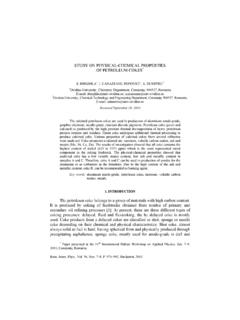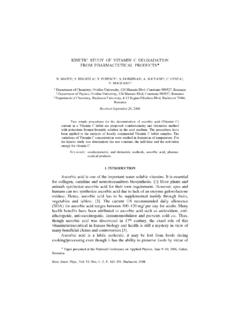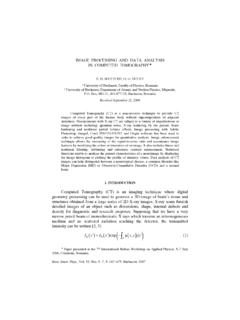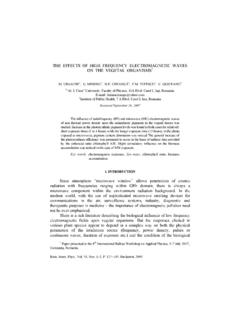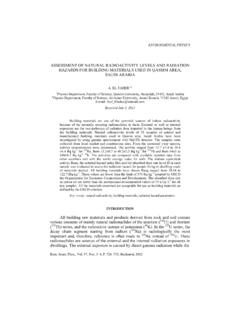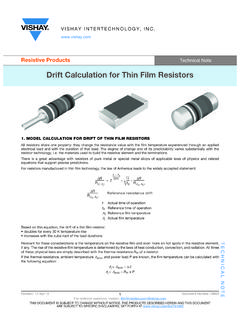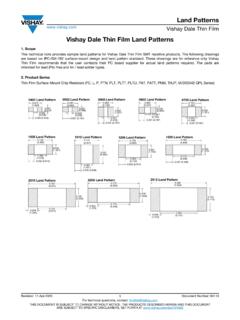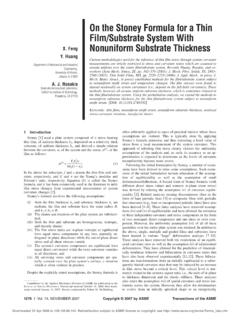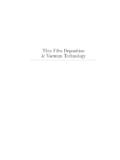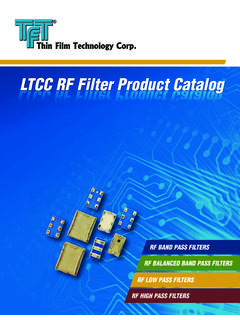Transcription of DEPOSITED INDIUM TIN OXIDE (ITO) THIN FILMS BY DC ...
1 DEPOSITED INDIUM TIN OXIDE (ITO) thin FILMS BY DC- MAGNETRON. SPUTTERING ON POLYETHYLENE TEREPHTHALATE SUBSTRATE (PET). ALI 1, K. IBRAHIM 1, OSAMA S HAMAD 3, EISA1, 2, FARAJ 1, and F. AZHARI 1. 1. School of Physics, University Sains Malaysia, Penang 11800, Malaysia 2. Department of Physics, College of Science, Sudan University of Science and Technology, Khartoum 11113, Sudan 3. School of Electrical and Electronic Engineering, University Sains Malaysia, Penang 11800, Malaysia E-mail: Received January 12, 2010. This paper is presenting the INDIUM Tin OXIDE (ITO) thin FILMS of low resistivity with different thicknesses.
2 The thin FILMS of ITO are DEPOSITED on polyethylene terephthalate (PET) substrate by means of DC-sputtering. The properties of the DEPOSITED FILMS samples were characterized by X-ray diffraction (XRD), scanning electron microscopy (SEM), transmittance electron microscopy (TEM), atomic force microscopy (AFM) and Raman spectroscopy. The obtained results for the surface morphology, the sheet resistance, the resistivity, the carrier concentration, Hall mobility, optical transmittance and the transmittance ratio of the ITO FILMS deposed on PET substrate are reported.
3 Details on the sample preparations and experimental details will be presented. Key words: INDIUM Tin OXIDE ; Polyethylene Terephthalate; DC-Magnetron Sputtering. 1. INTRODUCTION. INDIUM tin OXIDE (ITO) thin FILMS are wide gap semiconductors with a relatively low resistivity and widely used as transparent in the visible range of the spectrum [1]. Due to these characteristics, ITO FILMS are widely used for many applications [2-4]. Many works have been reported on the material ITO; however, most of them were using glass substrates to deposit the FILMS , while few reports treated the polymer substrates [6-7].
4 In order to deposit the ITO FILMS on these polymer substrates with certain properties and good adhesion, detailed study on structural and electrical properties of the FILMS is important. In addition, target utilization efficiency becomes increasingly critical when employing expensive target materials such as ITO [8]. Therefore, the improvement of target utilization efficiency reduces the cost of the film formation processes, in addition to eliminating downtime that result from exchanging targets. Recently, the growth of Rom. Journ. Phys., Vol.
5 56, Nos. 5 6, P. 730 741, Bucharest, 2011. 2 DEPOSITED INDIUM tin OXIDE (ITO) thin FILMS by dc-magnetron sputtering 731. ITO FILMS on plastic substrates by sputtering has been reported [9, 10]. Today there is strong need for the high-quality ITO FILMS for different applications should be DEPOSITED at substrate such as polyethylene terephthalate (PET) [11]. The ITO. thin FILMS commonly fabricated by different techniques such as electron beam (EB), RF and DC magnetron sputtering [12]. However, most of the FILMS are DEPOSITED at high temperature.
6 In this study ITO thin film DEPOSITED on plastic substrate (PET) at lower deposition temperature to prevent the PET substrate from damage. In this study, different thicknesses of ITO FILMS deposed on PET. substrates have been prepared by DC- sputtering method using low deposition temperature with different deposition conditions. The structural, optical and electrical properties of the obtained FILMS depending on deposition parameters, such as sputtering power and working pressure, have been investigated. 2. MATERIALS AND METHODS. thin Film Preparation: ITO FILMS , having thickness in the nm range, were DEPOSITED on PET substrates by DC magnetron sputtering technique (Model AUTO306).
7 The sputtering system utilized a sintered ITO target having an In2O3:SnO2 composition of 90:10 wt. % were used as targets after slightly compressing them into copper holders, 3 inches in diameter. The substrate temperature during deposition was maintained at low value. The sputtering deposition was carried out in a pure argon atmosphere at a pressure from 5x10-5 to 2x10 -3 torr and the sputtering power at 145 W. The substrate was PET sheet, which were degreased ultrasonically in a dilute detergent solution, rinsed in demonized water, and blown dry in N2 gas before they were introduced into the chamber.
8 The substrate was fixed directly above the target with a target-to-substrate distance of 6 cm. Before the sputtering deposition, presputtering was carried out under the same condition as the deposition. A parallel experiment on ITO FILMS DEPOSITED onto glass substrate was also carried out for comparison. The thickness of the ITO. film was determined for each time by using optical reflectometer (Model: Filmetric F20), with a lift-off type pattern marked on the substrate. The deposition times stared from 10 mints with equivalence varying to 15 and 20 mints.
9 The different ITO film thicknesses of nm, nm and nm were used in this work. The surface morphology for each thickness of the ITO FILMS was studied by Atomic Force Microscope (AFM, model: Ultra Objective) and scanning electron microscope (SEM, model: JSM 6460 LV). X-ray diffraction (XRD) measurements were performed using high resolution X-ray diffractometer system (model: PANalytical X' Pert PRO MRD PW3040). Structural changes of the ITO FILMS were evaluated by X-ray diffraction (XRD) measurements in the 2 mode. Carrier 732 Ali et al. 3. concentration and Hall mobility were obtained by Hall-effect measurement system (Model: Accent/HL 5500 PC).
10 The sheet resistance of the samples was measured with a four-point probe (Model: Changmin Tech CMT SR2000N) and the resistivity of the film was calculated. The sheet resistance was calculated by simple relation RS = /t, where, RS is sheet resistant, is the density and (t) is the thickness. The optical transmittance of the FILMS was measured as the transmittance ratio of a film coated substrate relative to an uncoated substrate by UV. Spectrophotometer (Model: U-2000 HITACHI). For very high levels of transmission, Fourier Transform Infrared Spectrometer System (FTIR, model: PERKEN ELMER SPECTRUM GX) infrared (IR) region and Raman and Photoluminescence spectroscopy system (model: Jobin Yvon HR 800 UV), has been used to characterize the optical transmittance.


